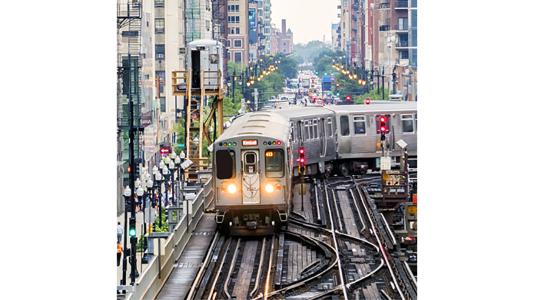
“COVID-19 has the potential to be more persistent than any previous interruptions,” says Aymeric Rousseau, Argonne’s Vehicle and Mobility Systems group manager. “Even if telecommuting levels don’t stay as high as they are now, they are not likely to come back to pre-COVID-19 levels. And even if people become more comfortable sharing space with others in a train or in a bus, some might continue to perceive this as a risk and continue taking other transportation modes, such as cars or bikes.”
An increase in cars on the road due to service cuts or persistent risk perception means congestion, energy consumption and more emissions, making a big dent in the environmental gains made possible over the past decade by advanced vehicle technologies.
With funding from the Department of Energy’s (DOE) National Virtual Biotechnology Laboratory, Argonne’s researchers worked in close collaboration with the Chicago Transit Authority (CTA) and the Chicago Department of Transportation (CDOT) to analyze the impact of possible future scenarios on bus and train boardings, congestion, energy consumption, emissions, the economy and equity, as well as quantifying the individual and simultaneous impacts of main levers like service cuts, telecommuting, risk perception and load limits.
The study used a novel workflow developed as part of the DOE SMART Mobility Consortium. Based on the fundamental idea that transportation is a system with a large number of factors, such as traveler behavior, e-commerce, vehicles technologies, that interact with each other, the workflow includes multiple tools to consider different metrics including mobility (POLARIS), energy (Autonomie) and emissions (GREET). Principal Investigator Omer Verbas, technical lead for network modeling and simulation, and project manager Josh Auld, technical manager for transportation systems and mobility, led the team.
“A dozen scenarios were developed by CTA”, says Verbas. “One of the unique feature of the study is that we were not only able to quantify the impact on transit, but also on the entire transportation system. With sustained low ridership, how many additional vehicles will be on the road? What is the impact of increased congestion on travel time and energy?”
Their analysis showed that if the public’s risk perception remains and employees continue to telecommute at least one day each week, a decline in ridership would result, on average, in a 22% slowdown in vehicle speed and an 8.5-minute increase in travel time. In the worst scenario, the city of Chicago could see an increase of 500,000 gallons of fuels per day, and the average single passenger vehicle could see a 15-minute increase per trip time due to congestion.
“Everyone is affected by transit, whether or not people use it or not”, says Auld. “Underserved communities would be affected most due to the lack of other transportation modes, raising concerns about equity.”
In addition, the increased congestion and resulting travel time will have a significant impact on discretionary trips. As a result, the economic impact of sustained low transit ridership could range from $3.7 billion to $7.2 billion, depending on whether or not services are cut.
“As one of its most efficient modes, transit is the backbone of transportation,” says Verbas. “Sustained decreased ridership would have a devastating impact across the entire transportation system. But increased ridership should be the ultimate goal if many metropolitan areas want to meet their transportation decarbonization targets.”